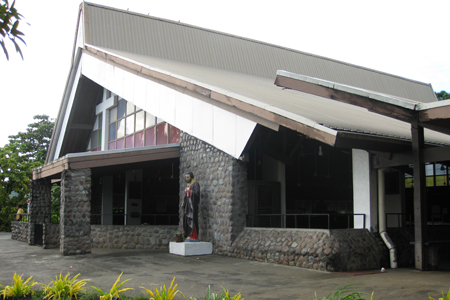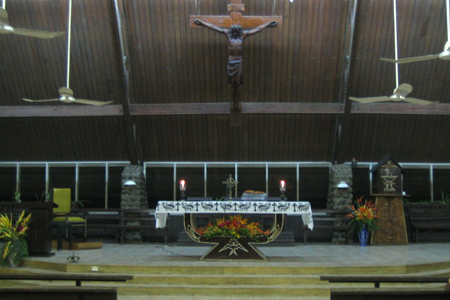| |
 |
 |
 |
| Comment on this report, or find other reports. |
 |
| Our Mystery Worshippers are volunteers who warm church pews for us around the world. If you'd like to become a Mystery Worshipper, start here. |
 |
| Find out how to reproduce this report in your church magazine or website. |
|
|
| 1830: Holy
Cross Cathedral, Honiara, Solomon Islands |
 |
 |
 |
Mystery Worshipper:
Amb3182.
The church:
Holy Cross Cathedral, Honiara, Solomon Islands.
Denomination:
Roman
Catholic, Archdiocese
of Honiara.
The building:
Holy Cross Cathedral is a 1970s contemporary style building
shaped somewhat like a tent. The design incorporates various
adjustments for the local climate and conditions. For example,
there are no side walls; instead, there are shutters that can
be opened and closed as the weather permits. The interior features
treacle-coloured local palm wood and is open and airy.
The church:
Missionaries began visiting the Solomons in the mid-19th century
and flourished during the years that the islands were a British
protectorate. Today, about one-third the population is Anglican
(Church of Melanesia), with Roman Catholics a distant second,
and the pentecostal South Seas Evangelical Church, the Seventh-Day
Adventist Church, the United Church (a merger of Presbyterian
and Methodist missionary parents), and other groups bringing
up the rear. The Archdiocese of Honiara stretches over five
provinces; there are two other dioceses as well. At the mass
I attended, there were worshippers from the different regions
and provinces of the Solomon Islands all joining together.
The neighbourhood:
The Solomon Islands is an archipelago consisting of about one
thousand small islands in the Pacific Ocean east of Papua New
Guinea. Honiara, the capital city, is on the island of Guadalcanal,
the site of a number of World War II battles that marked the
turning point in American vs Japanese dominance over the region.
Honiara is something of a hub, with ferry boats departing from
the harbour to the various Solomon provinces. The cathedral
sits on a hill above the harbour and has a commanding view of
Guadalcanal Beach.
The cast:
The Revd Herman Tiqe, parish administrator, was the celebrant.
There were eight altar servers in white albs with different
coloured embroidered ponchos: red for candle bearers, blue for
book bearers and green for general servers.
The date & time:
6 September 2009, 8.30am.
What was the name of the service?
Sunday Mass.
How full was the building?
The cathedral was totally packed. Children (or pikanini
as they are known in Pijin) were sitting on the floor, and as
is customary in the Pacific there were many more people mingling
about outside.
Did anyone welcome you personally?
Yes. A gentleman greeted me with "Good morning" as
I walked in. He then guided me to the first pew right in front
of the altar. I am not sure if it was reserved for visitors,
but I ended up being the only person sitting in that pew.
Was your pew comfortable?
Wooden slatted benches with backs, neither comfortable nor uncomfortable.
But there was no upholstery on the kneeler.
How would you describe the pre-service
atmosphere?
Reverential. There were a few people moving around the sanctuary
making preparations for mass.
What were the exact opening words of the
service?
"Good morning, dear brothers and sisters, and welcome to
our celebration."
What books did the congregation use during the
service?
There were no books except for the lectionary and the altar
missal. The congregation sang without hymn books.
What musical instruments were played?
Electric organ, accompanying a choir of students from the Bishop
Lavalle College in Honiara.

Did anything distract you?
A woman outside the church (but fully visible through the open
structure) kept walking backward and forward.
Was the worship stiff-upper-lip, happy clappy, or
what?
It was meant to be a mass in English but the priest kept slipping
into Pijin. The worship was standard Catholic modern with an
emphasis on the community gathered in prayer.
Exactly how long was the sermon?
11 minutes.
On a scale of 1-10, how good was the preacher?
7 – I followed only bits of the priest's Pijin. Every now
and again the congregation would break into laughter, so I can
only assume he was something of a wit.
In a nutshell, what was
the sermon about?
The gospel reading for the day was Mark 7:31-37 (Jesus heals
a deaf man with a speech impediment). God is full of compassion
for the physically challenged.
Which part of the service
was like being in heaven?
The singing. Melanesian singing is a joy to listen to, and the
congregation, led by the choir, sang very well. It must be said
that in the case of one hymn, the excellence of the singing
made up for the banality of the composition by a well-known
Canadian composer.
And which part was like being in... er... the other place?
Having to walk the entire length of the nave when the church was packed and sit in front of the congregation in a pew to myself.
What happened when you hung around after the service looking lost?
Toward the end of mass, the wedding banns were announced. Then,
after the dismissal and blessing, everyone left. I thought I
looked pretty obvious standing there all by myself, but no one
came up to speak to me and so I left too.
How would you describe the after-service
coffee?
Nothing was provided after the service.
How would you feel about making this church your regular (where 10 = ecstatic, 0 = terminal)?
8 – I probably won't return to Honiara for a while. But
when I do, I will make a point of returning to the cathedral
for mass.
Did the service make you feel glad to be a
Christian?
Yes. It was a pleasure to join with a congregation and worship
in their style and culture.
What one thing will you remember about all this in seven days' time?
Reading the wedding banns at the end of the mass. I have never
heard wedding banns read in a Catholic church. |
|
|
 |
 |
 |
| We rely on voluntary donations to stay online. If you're a regular visitor to Ship of Fools, please consider supporting us. |
 |
 |
 |
| The Mystery Pilgrim |
 |
| One of our most seasoned reporters makes the Camino pilgrimage to Santiago de Compostela in Spain. Read here. |
 |
 |
 |
| London churches |
 |
| Read reports from 70 London churches, visited by a small army of Mystery Worshippers on one single Sunday. Read here. |
| |
|
|
|
|


